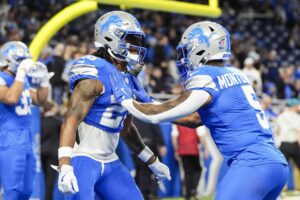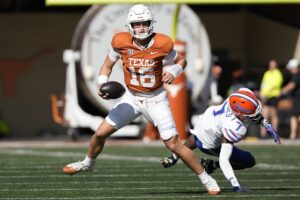The power of the Kansas City Chiefs in week three was once again their defense. Stats, charts, and trends all show where the success was, but at times that success is derived simply by superior, shut down play. All Chiefs stats in their victory pointed to a poignant defensive attack that shut down the Los Angeles Chargers for four quarters by forcing the Chargers to play away from successful play calls. Watching Philip Rivers erode in the first half was a fascinating spectacle, granted the Chargers offense was not at full health. However, the force the secondary – Terrance Mitchell, Daniel Sorensen to note – played with enhanced every weakness the Chiefs exploited ten-fold.
Offensively, the Chiefs played a good first half, but fell flat in the second half. The statistical trends showed a team regressing to a conservative natured offense afraid to push the ball around. Much of the emphasis was on an offensive line that became overwhelmed and committed a plethora of mental errors. Make no mistake – a win is a win in the NFL. Yet, week three raised serious questions about how sustenance the Chiefs mental aptitude is.
Kansas City Chiefs Stats and Charts – Invading Los Angeles
Chaos Theory
One of the interesting things about chaos theory is home field advantage. NFL teams that play at home get an outset advantage. Analytically, and physiologically, no team may have a worse home field advantage than the Los Angeles Chargers. The Chargers home field advantage was quickly negated by Chiefs fans who showed up in droves to a largely empty Carson, CA soccer stadium. In the chaos model of the game, the Chargers should have started on offense fast. Instead, the Chiefs defense made sure to send the trend completely in their control.
Melvin Gordon started off the first play from scrimmage with a first down run, attempting to set a physical tone early. However, the secondary would have no excuses, as Mitchell picked off Rivers’ second pass less than a minute into the game. The Chiefs got the ball on a short field, and Tyreek Hill’s speed made that field even shorter with an immediate score.
The next drive, that chaos model was completely sent out of control for the Chargers when Rivers was picked off again by Marcus Peters. Scoring on another short field, the Chiefs took momentum to heart.
However, in the model of chaos, not all things are predictable. Extrapolating unpredictability was Rivers – a stubborn, veteran quarterback. And he proved his stubborn nature by leading Gordon downfield. Notice, Rivers was not the scoring factor on the drive, rather Gordon’s rushing was the emphatic play that led the Chargers to score. Rivers created the confidence for the offense to succeed.
The difference is important to note for how the rest of the game unfolded. The Chiefs had a hole exposed in their run defense, yet the Chargers coaching staff failed to take advantage of that. As the Chiefs secondary dominated downfield (addressed statistically later), the coaching staff should have turned to pounding the ball.
Gordon’s injury, and subsequent inconsistent appearance may have put Anthony Lynn in a hard spot to adhere to a running game with Branden Oliver at running back. Let this point stand: when chaos gets out of control for a team to handle, it affects more than players. The physicality the Chiefs started off with set the tone, distracted the Chargers coaching staff, and ultimately forced the Chargers to go to a losing game plan in a game they could have won.
First Half Offense
The Chiefs first half offense is a study in misnomers. They only had the ball four different times, three times on short fields. Smith did exactly what he needed to do in three of those drives and scored. The play calling was immaculate and hit the Chargers weak and injured secondary. But, keep in mind this was all done on short fields.
Efficiency in analytics was the name of the game. The first drive exploited the Chargers defense deep right, a location where they have given up a 135-quarterback rating and a 50 percent success rate on the season.
The next drive, on another short field, exposed the other section the Chargers are weak at defending – the short left. By contrast to the explosive nature of the first drive, the Chiefs pounded the ball, then opted for two passes short resulting in an Albert Wilson touchdown.
A third drive resulted in a devastating sack after a Bryan Witzmann holding penalty. Closing off the first half on a short field, the Chiefs returned to the analytically successful run game and short left passes. While the Chiefs managed to kick a field goal on the final drive, a disturbing trend arose when Smith was sacked twice, and pressured when dropping back.
Second Half Offense
The trend of pressure continued into the second half when the Chiefs offense fell flat and failed to push the ball downfield. Negate Kareem Hunt’s 69-yard touchdown run, and the Chiefs spent five drives totaling a meager 95 net yards.
Take with stride what the offense did – they attacked the successful short field, but failed to hit the deep ball. Debatably, going deep with a lead is asking for a risky interception. However, as the first quarter showed, the Chargers are intrinsically weak against the deep ball. Chris Conley or Hill should have seen more opportunities to exploit weak coverage.
Analytics aside, the mental play of the Chiefs offense did not help either. On the first drive out of half, Travis Kelce committed a holding penalty that put the team in a hole. The next drive Eric Fisher put the team in a hole with a holding penalty. On the third drive a sack forced an 11-yard loss on what was a manageable third and three. The fourth drive Smith botched a snap and committed a delay of game. The fifth drive, Smith was put out of contention by again getting sacked.
The second half offensive drought was in dual nature due to mental errors and poor offensive line play. Unfortunately, the Chiefs deep passing scheme relies on setting up routes and five step drops – hence, the offensive line needs to provide sufficient time.
Smith completed 16 of 21 passes on the day, and did everything that he was asked to do and the Chiefs won. The play calling may have looked differently had Rivers gotten back into the game and forced the Chiefs offense to take a risky tone. Again, this points back to the effects chaos theory has on coaching mentality.
Speculative scenarios aside, the Chiefs offense did produce 189 yards total in rushing, with 172 yards alone from Hunt. Their running game will work throughout the season. Second point: to make that running game and athleticism shine, the Chiefs need to be cognitive of holding and delay of game penalties. To be blunt, avoid stupid mistakes. Third point: Smith can accomplish everything he is asked of, but the offensive line needs Mitch Morse back as soon as possible so a truly multi-dimensional offense can continue to evolve.
Defensive Dominance
The Chiefs secondary showed up in quarter one and never looked back. Rivers finished with a quarterback rating of 16.1, was sacked twice, and threw three interceptions. Much of that domination came in the first half, which as discussed previously, should have forced the Chargers to run; when the Chargers did run, Melvin Gordon was able to generate explosive plays.
Beginning with concern, the Chiefs are facing an almost inverse proposition of the run defense they had last year. Throughout 2016, the biggest run gaps for the Chiefs were in the middle of the field right over their defensive tackles. Runs over the left guard and left tackle saw a combined 60.5 percent success rate. Over center saw a 56 percent success rate.
This year, the Chiefs have limited inside run opportunities, only allowing 35 percent success through the center. This is a testament to the help Bennie Logan has provided up front, and what Rakeem Nunez-Roches has provided in a competent run defender in different substitution packages.
Over the left tackle and left guard, the Chiefs are allowing 53.5 percent success, a marginal improvement. However, the context that provides the whole story is the egregious 82 percent success running outside of the left tackle. And that success percent is based on 11 attempts, not a fluke of only five attempts.
The implications of the combined 53.5 and 82 percent success rate shows that running backs are not being contained on the right side of the defense. Running backs have the opportunity to hit the hole, and then bounce the ball outside for large gains. More agile backs will see tangential success against the Chiefs unless this glaring weakness is resolved.
The left side of the defense (outside of the right tackle) is only marginally better at a 64 percent success rate on the same number of attempts. Teams are also attacking the exterior at a higher rate. Only 32 and 33 runs (left, right respectively) were thrown at the exterior of the Chiefs defense in 2016 – offenses are set to eclipse that rate by hitting the exterior lanes times through three games.
Bringing this back into focus against the Chargers run game, that right side of the defense allowed 100 percent success outside of the left tackle. This included a nine-yard pop by Travis Benjamin on a fly sweep – an interesting approach to attack the Chiefs defense that may become a recurring problem.
Through the center, the Chargers only obtained 43 percent success, but on three of those runs gave up ‘explosive’ plays of ten yards or more. Hence, when teams do break a run into the second level, the secondary has a hard time supporting the Chiefs front seven. While that may be part to missing Eric Berry’s run support, a definitive improvement must occur in this region.
To paint the full spectrum of problems, the Chiefs will be playing the Pittsburgh Steelers (Le’Veon Bell), Oakland Raiders (Marshawn Lynch), Dallas Cowboys (Ezekiel Elliott), and Miami Dolphins (Jay Ajayi) – all multi-talented running backs who can run outside of the tackles or right through the center.
All the pain and woes being painted do not do justice to the overt success the secondary had against Rivers. Through three games, the Chiefs are allowing less than 50 percent success across all passing cones. The highest success is seen in the short middle, where quarterbacks have a very average rating of 91.
When Rivers is forced to throw the ball 40 times or more, he is an abysmal 11-34, averaging two touchdowns, an interception, a 61.8 completion percentage, 323 yards passing, and an 87.2 quarterback rating. Hence, when Rivers has to throw a lot, it’s the result of a poor supporting cast. Bob Sutton forced a young Chargers coaching staff to fall right into their own worst gameplan. The Chiefs held Rivers to a 37.2 traditional quarterback rating, and forced him to average 5.9 yards per completion with a 50 percent completion rate.
The deep and middle part of the field, usually where Antonio Gates or Hunter Henry attack, was completely negated by Mitchell and Peters. Peters was targeted seven times, for three catches and a meager 30 yards. Mitchell followed up with nine tackles and four passes defended.
Physical play downfield was the major emphasis of the Chiefs defense. By playing more aggressive and meeting receivers in their routes, the defense out-hustled what Keenan Allen or Benjamin fought with; the Chiefs defense simply gave Rivers no opportunities to look downfield.
In summation, the Chiefs defense forced head coach Lynn and quarterback Rivers to lose their intrinsic successful play calls, and switch to desperation play calling. Insistent pressure and more intense play was point and tangent to another dominating Sunday.
Main Image:






